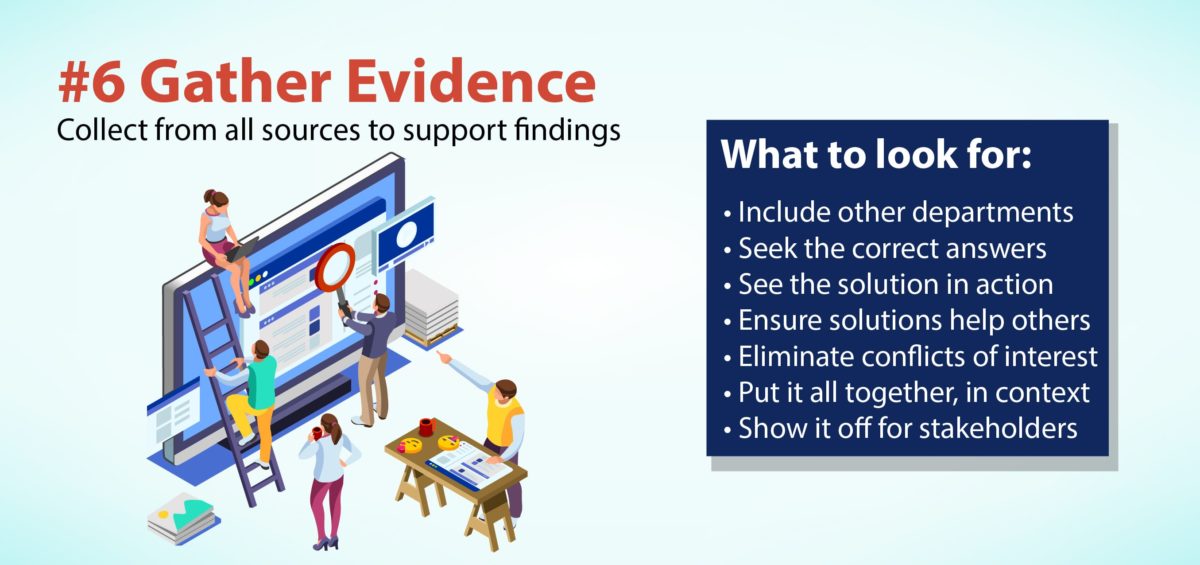#6 in the new Blog Series: How to Evaluate Legal Operations Solutions
Evaluating Legal Ops Solutions: Sixth, Gather Evidence
Now that you’ve created your evaluation team, asked the right questions, determined the actual needs, set achievable goals, and watched out for dealbreakers, it’s time to begin the process of gathering the evidence that will justify either moving forward or stopping the evaluation. The evidence is non-judgemental, presents the facts, and supports or stands against bringing in the technology solution. Your team’s job is now to collect and present the evidence that drivers the outcome… either way.
Gather Evidence
Evidence begins with gathering information and figures, but it must go beyond collecting mere facts.
As in a court proceeding, evidence consists of assembling facts that support a conclusion. In this case, the conclusion is that your legal department needs a legal operations solution that will positively impact all aspects of the company.
To offer the most relevant information possible, your team will gather the evidence that either proves the solution will meet the needs or it doesn’t. Either way, your task will be to collect the best information at your disposal to lead to the most intelligent outcome, even if that means you have to move in another direction.

-
Include other departments
You need to look beyond your department and involve people outside the legal department – from operations to marketing and finance – to get the information to support the evaluation that will ultimately strengthen your position when requesting a technology solution.
Ninja tip: Adding more departments means your evidence will cover more of the overall business. More information doesn’t necessarily increase complexity when broadening your scope of company data flows, but it does add depth to the evidence for later review.
-
Seek the correct answers
Earlier, we covered the critical questions to ask. Now is the time to gather the answers that build your case. What are the long-term and short-term goals in adding the new technology solution? What stands in the way of meeting these goals? At this point, what evidence can the solution provider add to your use case? Categorize the answers you have and provide a clear synopsis for decision-makers. Once they see the clear answer, it’s easier for them to make an intelligent decision confidently.
Do their answers stack the evidence in favor of proceeding, and do they address your challenges? If so, make sure to conclude that.
Ninja tip: Ensure your conclusions are based on the best evidence. Your team is closest to the subject, so provide executive summaries. It’s hard to guess what others will see from any evidence, so focus on evidence that proves your outcome without interpretation.
-
See the solution in action
No solution evaluation is complete without getting under the hood and seeing the tool at work. Assemble your team and walk through the key features. Here’s where the technology providers can differentiate their solutions. Call for demonstrations or hands-on trial installations that allow your super-users to test it out. Collect the feedback to determine if it lives up to the promises offered and your expectations. Does it meet your requirements? Will it work? Will it do what you need it to do? If not, cut bait and move on. Don’t waste any more time on this solution.
Ninja tip: If you do determine that the solution is not up to the task, know that this evidentiary step helped save time and effort that might have been wasted on an unworkable solution. But if it does meet your needs, you’re on the path to success.
-
Ensure solutions will help others
Ask leaders and teams from other departments if the information you’ve already collected will help them achieve their goals. If not, what else would they need to move forward? Would having them on the demonstration help them see the value of using it? Adding others to the hands-on demo adds additional evidence that supports the solution. Not only will it guide you in making your case for a new legal department solution, but it will also show your genuine support for the company as a whole.
Ninja tip: Adding more department members to the demos can provide additional support for the solution. Champions from other departments can add funding, make recommendations, or uncover additional issues to be overcome before proceeding.
-
Eliminate conflicts of interest
Identifying potential dealbreakers will have uncovered any facts and opinions that might develop into conflicts of interest between your objectives and those of other departments. Once you have the evidence in hand, more may have surfaced. It’s time to ask the key stakeholders about their concerns. If there are additional conflicts, ask the provider if the solution can overcome these. Are there workable results?
Ninja tip: Frank conversations are needed at this point. It’s time to bring any potential conflicts to light. Consult with your team, other department heads, and the provider.
-
Put it all together, in context
A business decision only makes sense when its rationale makes sense. Each decision-maker may have unique criteria they are looking for, so make sure the evidence is presented in a way that supports each desired outcome. In the light of day, your combined goals should be the storyline you use when gathering your supporting information. Assemble the story together in a manageable and easy-to-read format with each aspect of evidence clearly outlined and summarized. The best evidence loses its impact if it is hard to understand or uses information that isn’t relevant to the reader.
Ninja tip: We are trained at an early age to listen to and remember stories. Multiple survey results show that evidence presented using a storyline is better received, easier to understand, and often retained longer than a simple report of facts and figures. Use this technique to build your case for the technology into a compelling narrative.
-
Show it off for stakeholders
Just as courtroom evidence has no value until presented to a jury, your evaluation evidence has no impact until it is put in front of the executive decision-makers who can sign the contract. The evidence should be concise, persuasive to stakeholders, and directed toward solving a problem that can help accomplish goals. The ultimate decision is not up to you or your team. Your job is to deliver the most factual and insightful evidence that builds a case to approve the purchase or not. The evidence will provide the facts that you did your homework for the betterment of the entire company.
Ninja tip: Let the evidence point to what you found in a clear and concise way. Prepare your team to provide an individual report for each decision-maker. This could mean each has personalization that addresses unique needs in the language that makes the most sense to them. In the end, this extra work typically leads to more positive results.
Consider whether the need is great enough to commit your collective resources.
While every company’s checklist will vary, yours should look something like this:
- Assemble the team (Read this post)
Start a conversation with leaders in every business unit that touches yours, and, if appropriate, invite them to be part of your evaluation team. - Ask incisive questions (Read this post)
Get to the heart of the business issue and identify a quantifiable goal. - Evaluate the need (Read this post)
Consider whether the need is great enough to commit your collective resources. - Set goals (Read this post)
Look at quantifiable goals for short-term (now through the next year) and longer-term (through the next 3-5 years) time periods. Make them measurable. - Watch for dealbreakers (Read this post)
Discuss what, if anything, would jeopardize a decision. - Gather evidence (You’re reading this post)
Collect evidence from every source possible. Learn how to present it in the most effective way to support your findings. - Follow best practices
It’s quite possible that examples of what other teams have done will include a formal or informal list of best practices – or at least some insights for creating that list.





